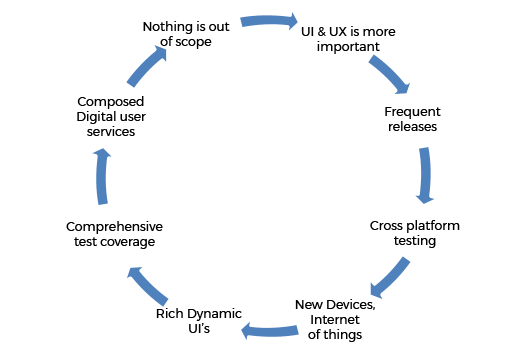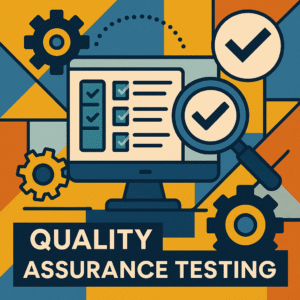CloudQA – Why User Experience is of utmost Priority to Deliver Quality
As a product based firm CloudQA often in its demo sessions is hit by a query – How do you assure quality to the digital audience each time? Our answer is simple – We value user experience more than the code. Our testing approach is user-centric, and if research shows users are deviating from the traditional approach, we improvise and align our testing strategy with them. Our Review and Fixtures models make sure to explore the product development Lifecycle, fix the testing approach and rearrange the components. How?
Read on to know How We do it…
Recognize the Transformation

Users
The users are “SUPERPOWERFUL” they can push a product to its High and could even let it shatter on the ground. Many of the Founders put in their efforts to research if the idea is worth to be converted into business, but most of them forget the packaging of the idea. Does that serve the purpose? Many firms try to get users to try their beta version before rolling out it to the users, but is it not too late to put your product under stress? What if it fails?
Technology
Would you like to go for a desktop version or a mobile app as well? Would that be available only for Android or even iOS? Would open source tools be the right choice? Could these be integrated seamlessly with other third-party tools? These all questions may have a different answer when approached via the budget and timeline the firm has. But think about it from user perspective – Are the technology used safe and secured for the users? Would users be more inclined to a web version or an app would be good-to-go? Could constant monitoring be more helpful in predicting disaster before it happens?
Timeline
The timeline is another crucial aspect of recognizing the change. Users need things at a super-fast speed. They are not willing to wait for your monthly release; they need to be updated software version on a daily basis [at least].
Data
Users no longer wish to provide Name, Age, email address type data set again and again. The software should be smart and intelligent enough to pick it up and allow users to log in and showcase personalized dashboard/preferences.
With these known transformations, the traditional product development Lifecycle needs to straighten out. Currently, the three categories of Product Development Cycle that are floating are –
- Traditional monolithic desktop application – Products like MS Office or Chrome browser that could run independently on a desktop.
- Core Services – These are the software pieces that are in the form of an API and mostly need an integration. Just for example – payment, storage, ad networks, analytics
- Standalone yet Integrated Applications – These are the products that are mostly user facing and could be integrated with any other third-party products or core services. They could work independently but may also be integrated with others. Just for example an online food ordering joint may work independently but could also be combined with Google Maps to know your location and provide you with personalized choices.
Now we know “the transformation” and the “product development category” so now putting up a test plan be an easy job? Not Really! Albert Einstein said
You can never solve a problem on the level on which it was created.
Hence each application needs to move at a different level to be tested.

Reviews and Applying Fixtures
If you already have a Test Automation suite we run a “Quick Review” to know why is it breaking. Based on our experience and research here are some of the common reasons for why test automation is breaking –
- Low User Engagement – Based on Quettra’s data shows that 77 percent of users never use an app again 72 hours after installing. After a month, 90 percent of users eventually stop using the app, and by the 90-day mark, only 5 percent of users continue using a given app. All this data highlights an interesting fact that your app is not engaging enough. Some of the reasons highlighted by users are – App Crashing, Poor performance and usability and excessive use of memory.
- Halted continuous delivery and DevOps – Another research shows that only 8% teams could achieve nearly 50% of test automation and 41 % of the teams had less than 1% test automation achieved. This data highlights the fact that even though the efforts were made but were not continuous and did not involve DevOps.
- The Huge cost of testing – Testing needs tools and resources that come with a price tag. Hence many firms cut the budget to save pennies and roll out bad quality product.
- Gaps between business owners and QA – There exists a huge gap between the product owner specifications and testers viewpoint that reflects the quality of the product.
Once we have identified the “problems areas” we apply Fixtures –
Ways to fix to test broken approach
@CloudQA we try to provide a remedial solution to patch up the Test Automation Suite to enable in offering a quality product. Here they are –
Be the User
Have you ever thought how a knee replacement device could be tested? As a tester, would you cut your leg and then test it? Well, not really but the feel of the user is of utmost important for a tester designing the test cases. And these scenarios cannot be achieved by just following a High-level requirement document; you need to think and act like him.
Scope of Testing
Testing is not restricted to functional document, based on usability, performance and even security are the key aspects that need to be covered in the scope of work. In fact, our recent article on why testers need to be ethical hackers gives you top reasons to cover security aspects for sure.
Automate All Processes
While a single sign in is a user preferred choice, make sure to apply it to automation process as well. Single click should result in test case execution, review test results and analyzing the root cause. So go beyond test execution…..go for automation of all processes.
Reporting test status in terms of user experience
As a user, how/what would you rate a functionality of an app? Would the user have enough information to know about the fields? Does the UI looks scatter? Try to challenge yourself as a user, and you could surely give the best experience they ever had.
I remember my 8th-grade economics lesson – democracy is
For the people
By the people
Of the people.
And trust me that’s the same about your product. Believe in the power of users!
LIKE THIS POST SHARE IT WITH YOUR FRIENDS
RECENT POSTS
Guides

How To Select a Regression Testing Automation Tool For Web Applications
Regression testing is an essential component in a web application development cycle. However, it’s often a time-consuming and tedious task in the QA process.

Switching from Manual to Automated QA Testing
Do you or your team currently test manually and trying to break into test automation? In this article, we outline how can small QA teams make transition from manual to codeless testing to full fledged automated testing.

Why you can’t ignore test planning in agile?
An agile development process seems too dynamic to have a test plan. Most organisations with agile, specially startups, don’t take the documented approach for testing. So, are they losing on something?

Challenges of testing Single Page Applications with Selenium
Single-page web applications are popular for their ability to improve the user experience. Except, test automation for Single-page apps can be difficult and time-consuming. We’ll discuss how you can have a steady quality control without burning time and effort.

Why is Codeless Test Automation better than Conventional Test Automation?
Testing is important for quality user experience. Being an integral part of Software Development Life Cycle (SDLC), it is necessary that testing has speed, efficiency and flexibility. But in agile development methodology, testing could be mechanical, routine and time-consuming.





